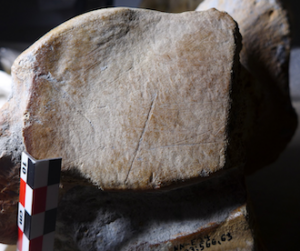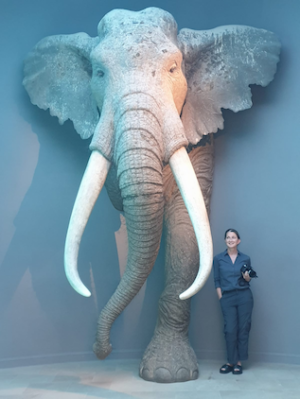
AMERICAN ASSOCIATION FOR THE ADVANCEMENT OF SCIENCE (AAAS)—New evidence* suggests that straight-tusked elephants, the largest terrestrial mammals of their time, were hunted and butchered by Neanderthal groups that were larger and less mobile than previously thought. Sabine Gaudzinski-Windheuser and colleagues discovered telltale signs via cutmarks on 125,000-year-old skeletal remains excavated from central Germany more than 25 years ago. From 1985 to 1996, a team of researchers uncovered the remains of more than 70 of these elephants (Palaeoloxodon antiquus) from a site near Halle, Germany called Neumark-Nord 1, which constitutes the largest known assemblage of P. antiquus. Although these remains have been studied extensively, researchers have so far been unable to confirm speculations that Neanderthals – who also inhabited Eurasia during that period – may have hunted or scavenged the giant creatures. Now, Gaudzinski-Windheuser et al. have identified cutmarks on skeletal remains from the Last Interglacial that suggest these elephants were routinely hunted and butchered by Neanderthals. By evaluating bone surfaces under a microscope and reviewing what was already known about the remains, the researchers inferred that Neanderthals methodically cut, hacked, and extracted parts of the animal, leaving distinct markings on the bone surfaces. With male elephants weighing as much as 12 tons, butchering an animal of this size must have involved multiple tools and butchers, taken days to complete, and yielded copious amounts of meat that could have lasted for up to 3 months for as many as 25 people, the researchers say. They speculate that Neanderthals must have lived more stationary lifestyles in larger units than commonly supposed. In a related Focus, Britt Starkovich notes that “It is increasingly clear that Neanderthals were not a monolith and, unsurprisingly, had a full arsenal of adaptive behaviors that allowed them to succeed in the diverse ecosystems of Eurasia for over 200,000 years.”
Summary author: Nyla Husain
_______________________________

Deep cut marks on the heel bone of a male elephant (Individual E24), ~50 years of age at death. Easily visible with the naked eye, the longest cut mark in the center of the picture is c. 4 cm. Disarticulation of foot bones enabled access to the rich fat deposits in the elephant’s foot cushions. Wil Roebroeks, Leiden
_______________________________

Cut marks on a foot bone of an elephant (Individual E30), made by stone tools during disarticulation of the foot (Scale bar = 5 mm). Sabine Gaudzinski-Windheuser/Lutz Kindler, MONREPOS
_______________________________

Dr. Sabine Gaudzinski-Windheuser (height 160 cm) next to a life-sized reconstruction of an adult male straight-tusked elephant (P. antiquus), in the Landesmuseum für Vorgeschichte, Halle, Germany. Lutz Kindler, MONREPOS
_______________________________
Article Source: AMERICAN ASSOCIATION FOR THE ADVANCEMENT OF SCIENCE (AAAS) news release
*Hunting and processing of straight-tusked elephants, 125.000 years ago – implications for Neanderthal behaviour, Science Advances, 1-Feb-2023. www.science.org/doi/10.1126/sciadv.adg6072
_______________________________
Advertisement

Don’t miss out on this unforgettable evening as Dr. Hawass reveals the most closely guarded secrets of ancient Egypt and presents his groundbreaking new discoveries and latest research live on stage. As the man behind all major discoveries in Egypt over the last few decades and director of several ongoing archaeological projects, Dr. Hawass may yet surprise you with unexpected revelations that will make news across the world.
_______________________________





